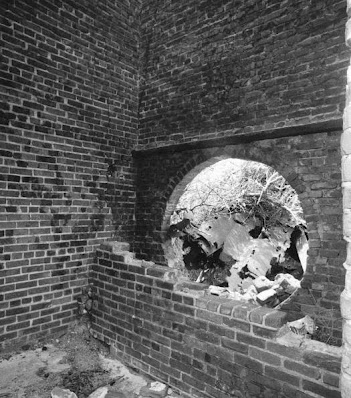 |
| Menhaden plant chimney, Phillips Island July 2004 – Bland Simpson |
An excerpt and photographs from Bland Simpson’s book The Inner Islands: A Carolinian’s Sound Country Chronicle (University of North Carolina Press, Sept. 1, 2007)
Phillips Island
Fifty years ago, many thousands of egret and herons called Lenoxville Point their home—this was the site of the town of Lenoxville, chartered and laid out in 1816 on the west bank of North River’s mouth, just east of Beaufort, but never built.
Since the mid-1950s this Lenoxville Rookery split, many of the Audubon protectorate moving south from there and setting up on Middle Marsh Island, behind Shackelford Banks, the rest heading several miles west and finding solace in the myrtle and liveoak and yaupon thicket on the north end of little Phillips Island, in Newport River near the Haystacks, the marshes that border Morehead City.
 |
| Old gear, Phillips Island July 2004 – Bland Simpson |
In the 1990s much of the Phillips colony moved to one of the Bogue Sound islands—Wood Island, a quarter mile long, nearly fifteen miles west in Bogue Sound, about halfway between Rock Point at Salter Path and Archer Point at Emerald Isle—but the egrets have been returning to Phillips, one of the most visible and viewed of all Carolina’s inner isles, with its red brick chimney standing out against the green thicket nearby.
People in cars driving across the high span of the Newport River bridge cannot help but have their eyes drawn to this spot of color to the north, and to the bright white egrets circling it or enfolding themselves with their young in the scrub. Those who view Phillips from Town Creek on the Beaufort side may see it of a morning across the emerald-green marsh and, as the sun cuts through a slow-moving scud silvergray as smoke and suddenly lights up the old chimney like an obelisk of red clay, gasp.
 |
| Inside the chimney, Phillips Island July 2004 - Bland Simpson |
Long ago the lone chimney served a fish plant, Melt Lee’s Newport Fisheries, one of Carteret County’s menhaden cookers, and now near the brick tower’s base has sprouted an old gear, its long shaft sprung and bent over like some enormous Picassoan daisy. In the salt grass beyond the chimney thicket stood a clutch of metal plates, rusty brown boxes wherein the menhaden were once boiled down, reduced to fishmeal for feed or fertilizer before the business soured and failed after WWI.
Local folks approaching seventy cannot recall the factory as a working place, and believed it went out of business in the 1930s or ‘40s. Yet Corinne Webb Geer remembered all too well that her grandfather, Irving Davis, had fallen from a scaffold while working at the Phillips Island plant and died from his injuries. In its time a man named Ed Corham ran the plant, and then Llewellyn Phillips—whose family owns the island yet and whence it takes its name—took over, buying firm, factory and gear for $2,701 in 1932. When the old fish plant finally burned one late September night in 1953, hundreds of people drove out and parked on the Beaufort-to-Morehead causeway to watch the great blaze…"